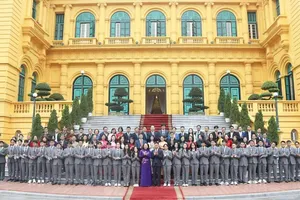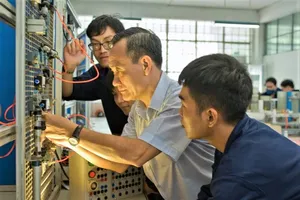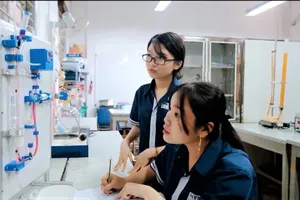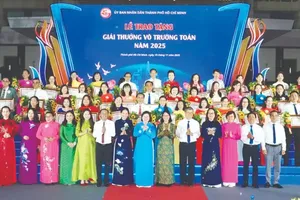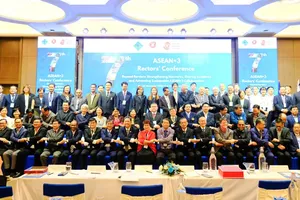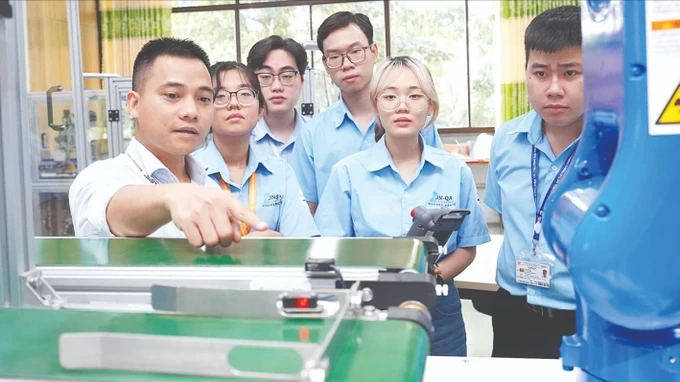
Schools and businesses join in training personnel for microchip design
Ho Chi Minh City is at the forefront of semiconductor microchip workforce development, with universities such as University of Technology, University of Science, Information Technology - UIT (under HCMC National University), Technical Education University, and Industry University proactively launching early training programs. The city currently leads the nation in supplying talent for the semiconductor industry, with nearly 5,000 engineers.
In addition to telecommunications electronics, universities in the southern metropolis have introduced various training programs related to microchip technology, including mechatronics, computer engineering technology, embedded systems, and IoT. More recently, specialized programs in microchip design engineering have also been launched to meet industry demand.
Associate Professor Nguyen Minh Tam, Head of the Faculty of Electrical and Electronics, Ho Chi Minh City University of Technical Education revealed that statistically, more than 13 percent of engineers working in the semiconductor field in Vietnam received training at the university.
In addition to universities’ training personnel for the industry, technology enterprises are playing a key role in training microchip professionals. Notably, FPT Corporation is advancing its "Make in Vietnam" chip strategy, with a dedicated microchip design team trained in leading semiconductor nations such as Japan and the United States. Leveraging its technological autonomy, FPT can develop customized power chips tailored to specific devices, maximizing product performance. The corporation has set an ambitious goal of training 10,000 semiconductor professionals for Vietnam by 2030.
In recent years, the Ho Chi Minh City Semiconductor Industry Association (HSIA) has carried out many activities to contribute to the development of the Ho Chi Minh City microchip industry, especially in supporting and linking human resource training activities. HSIA has connected American chip software firm Synopsys Company and Ho Chi Minh City High-Tech Park to sign a cooperation agreement to provide 30 licenses in three years - worth US$20 million training 30 lecturers for universities in the southern largest city.
Similarly, CMC University (under CMC Group) has established the Faculty of Microelectronics and Telecommunications to develop specialized talent for the semiconductor industry. The university has launched a major in Electronic and Telecommunications Engineering Technology and designed specialized training programs focused on semiconductor chips. Additionally, it has invested in the IC Design Lab, providing students and engineers with access to advanced microchip design technology.
According to Nguyen Phuc Vinh, member of the Executive Committee of the Ho Chi Minh City Semiconductor Technology Association, Vietnam has more than 50 FDI enterprises in semiconductor chip design, manufacturing, and electronic applications. Universities in the southern largest city are currently supplying a significant number of specialized microchip engineers and other personnel to these businesses.
HCMC businesses invest heavily to capitalize on new market opportunities
The global semiconductor industry has experienced robust growth, expanding by 14 percent annually since 2001, according to a survey by the Ho Chi Minh City Semiconductor Technology Association. This thriving sector is projected to reach US$1 trillion in value by 2030, necessitating the addition of nearly one million workers.
Vietnam aims to become a global chip design hub by 2030. From 2019 to the present, Vietnam has required approximately 1,000 engineers annually in the field of chip design. The country aims to become a leading regional and global chip design center, ranking among the world's top 5 by 2030 with a workforce of around 50,000 people.
Ho Chi Minh City alone needs to train and improve the skills of about 40,000 engineers working for the semiconductor industry from now to 2030, or about 6,000 engineers per year.
Associate Professor Vu Hai Quan, Director of Ho Chi Minh City National University, said that the school trains about 6,000 students per year in majors directly and indirectly related to semiconductor technology.
He revealed that from 2023 to 2030, Ho Chi Minh City National University aims to provide in-depth training in microchip design, meeting the demand for high-quality human resources for the development of the microchip industry in Vietnam and the world.
Member universities are set to train over 1,800 engineers and 500 master's graduates in microchip design. Ho Chi Minh City National University will develop a cutting-edge training program, certifying approximately 15,000 engineers with industry-recognized and international microchip design credentials.
The Prime Minister has issued Decision 1017/QD-TTg approving the program ‘Developing human resources for the semiconductor industry to 2030, with a vision to 2050’. As per the Decision, Vietnam aims to train at least 50,000 skilled professionals, including 42,000 engineers and bachelor's degree holders, 7,500 graduate students, and 500 doctoral students, to serve the country's semiconductor industry by 2030.
To achieve this goal, the State is investing in teaching staff and training facilities. Specifically, the State plans to establish four new national-level shared semiconductor laboratories at the National Innovation Center, Hanoi National University, Ho Chi Minh City National University, and Da Nang University. Additionally, the State will invest in 18 standard semiconductor laboratories at 18 public universities across the country.
Currently, many universities have built a team of highly qualified lecturers, trained from countries and territories where the semiconductor manufacturing industry is developed, such as the US, Japan, Korea, Taiwan. Many schools have invested in their own facilities as well as linked with multinational corporations to train human resources in the semiconductor industry. For instance, Vietnam-Germany University has cooperated with Stuttgart University (Germany) in training in semiconductor and microchip engineering.


